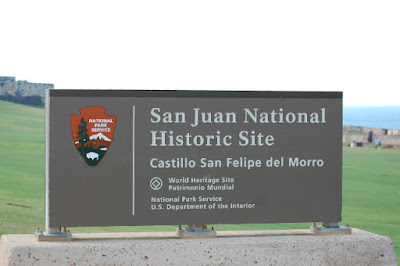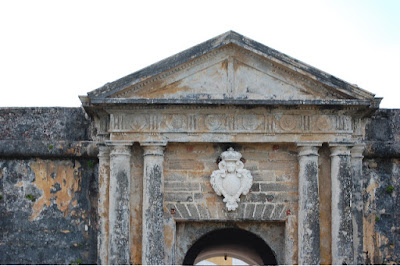A Mighty Fort Stands Proud for More than 500 Years
San Felipe Del Morro Castle, Old San Juan, Puerto Rico
If you’ve never visited, you will be enchanted by the historic European flair and charm of Old San Juan. This picturesque, sun-drenched town dates back some 465 years, and invites visitors to explore its winding cobbled streets lined with brightly painted buildings with iron balconies, shaded by big, old leafy trees. On the northwestern point of San Juan, high atop a promontory, is the mighty Del Morro Castle. It was designated a National Historic Site in 1949 and more recently a World Heritage Site in 1983 by UNESCO. Del Morro accommodates over 2 million visitors per year and is a must-see for all who come to the island.

Approaching Del Morro by land
San Felipe Del Morro, also referred to as El Morro, was named in honor of King Phillip II, who ruled Spain from 1554 to 1558. The 6-story fortress, built upon 74 sprawling acres, is considered to be the largest fort in all of the Caribbean. What started as a simple one-tower light house, grew into the massive structure we see today. It was constructed over the course of almost 5 decades - from 1540 to 1589 - and was well worth the effort. During the late 1700’s many of the walls of the castle were rebuilt. In 1897, some of the walls were taken down, to allow the city to grow. Then in 1992, more renovations were made in honor of the 500th anniversary of Christopher Columbus’ discovery of Puerto Rico.

Declared a World Heritage site in 1983
Del Morro is renowned for its garitas, which are sentry boxes covered with domes along the castle’s outer walls. These provided shelter for those on the lookout for enemies approaching from the sea. The walls of this impenetrable fortress are said to be 18 feet thick, aiding in the structure’s survival of many attacks under Spanish rule, including one by Sir Francis Drake in 1595. The British were later the only outsiders who were successful in seizing the fort. But they accessed it from the land behind, and the occupation lasted a mere 33 days. In 1898, during the Spanish-American War, the US Navy attacked Del Morro. Following this brief battle, the Treaty of Paris was signed, and Puerto Rico was ceded to the US by Spain.
Visitors to the fort are given a helpful map to navigate the imposing structure. One interesting feature on the main plaza includes a well that leads to an underground cistern that held 220,000 gallons of waters – enough for a one-year supply for the soldiers of the fort when it was under siege. Other highlights include chimneys that supplied air to rooms on lower levels, living and cooking quarters, ramps with platforms where soldiers could rest their heavy cannons, the observation deck with expansive views of the sea, and the water battery, where cannons were placed very low - almost on sea level. Across the bay is a much smaller fort, San Juan de la Cruz, which served to provide deadly cannon crossfire when an enemy was approaching. Three flags proudly wave from atop the Del Morro: the Old Spanish flag; the America flag; and the Puerto Rico flag.

A view from the lawn in front of the castle looking over Old San Juan and the Atlantic Ocean
The highlight of my visit to Del Morro was looking out over the Atlantic atop the windswept decks of the castle. I could vividly imagine what life must have been like for the Spanish soldiers in the hot, humid fort during the sixteenth century, as enemies approached from the water. The tropical climate and azure-colored sea are distinctive to the islands of the Caribbean. Breathtaking views can also be had from the front of the castle looking over the expansive green grass sloping down to the sea.

Entrance to Del Morro
If you do schedule a trip to Puerto Rico, plan to spend an entire day in Old San Juan. There are other historic buildings to explore, some excellent restaurants and great boutique shopping. The people are friendly - most everyone speaks English in San Juan - and the weather can’t be beat. Many visitors to the island also enjoy a journey to the misty rainforest. The island itself is only 100 X 35 miles, though it has a population of close to 4 million.
San Felipe Del Morro Castle
San Juan National Historic Site
Fort San Cristobal, Norzagaray Street
San Juan, PR 00901 (787) 729-6777
http://www.nps.gov/saju/index.htm
Open to the public everyday 9:00am to 6:00pm except on Thanksgiving Day, Christmas Day and New Year's Day. $3 entrance fee for adults, free for kids 15 and under. Fees may be higher on national holidays. Steep, old steps are part of the tour. Plan to spend at least an hour here.
Puerto Rico is a US Territory, and residents are US citizens. US currency is used, and passports are not needed for travel from any US state to the island. There are also no customs for US travel, though there is an agricultural check of luggage for all travelers when leaving Puerto Rico. So give yourself a little extra time at the airport when you are leaving. Mail is sent through the US Postal Service at the same rate as the rest of the US. Many US cell phone companies do not charge roaming fees when you use your phone on the island to call US states. But check with your phone carrier before leaving so you are not unpleasantly surprised when you get your cell phone bill upon your return.
All photos courtesy and copyright Debbie Glade.
Debbie Glade/smartpoodle is the Geography Awareness Editor for Wandering Educators.
